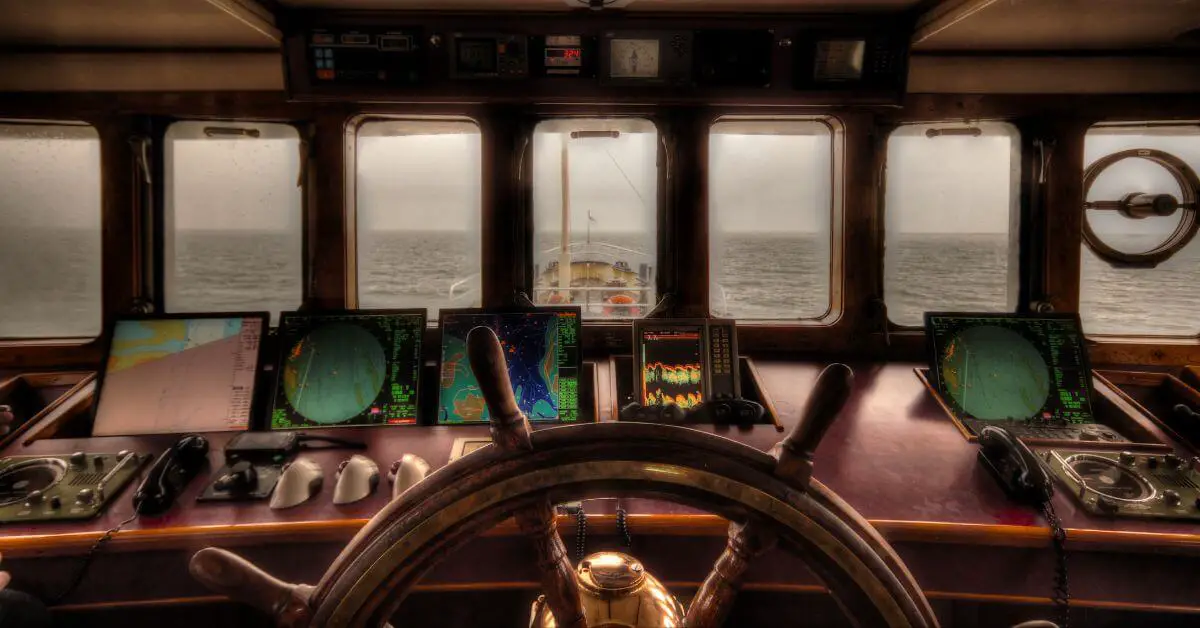The ship steering wheel holds a special place in maritime history, from tales of daring adventures on the high seas to modern naval expeditions. As an enduring symbol of navigation and control, this iconic instrument has guided sailors across vast oceans and shaped the course of civilizations.
The ship steering wheel, also known as the helm, represents the link between the ship’s crew and the mighty forces of wind and water. Its distinctive design and role as the centerpiece of the ship’s bridge have made it an integral part of nautical lore and popular culture.
This article will explore the fascinating history, symbolism, and mechanics behind ship steering wheels. We will delve into their evolution from ancient times to modern innovations, their significance in maritime traditions, and their crucial role in steering massive vessels across treacherous waters.
What is a Ship Steering Wheel?
A ship’s steering wheel, also referred to as the helm, helm wheel, or ship wheel, is a device used to steer and control the course of a water vessel. It is a vital component of the ship’s steering system, allowing the helmsman to direct the ship’s movement and navigate various conditions and obstacles.
The steering wheel is typically circular and mounted on a vertical column called the helm post. Depending on the vessel’s design and requirements, it is usually made of durable materials such as wood, metal, or composite materials. The steering wheel size can vary significantly, with larger ships having larger wheels to provide better leverage and control.
The wheel is divided into sections called spokes, which radiate outward from the center. These spokes provide structural support and serve as grips for the helmsman to hold onto and turn the wheel effectively. The number of spokes can vary, but eight is a standard configuration for modern ship steering wheels. Decorative elements are often added to the spokes, adding a touch of elegance to the overall design of the wheel.
The steering wheel is connected to the ship’s rudder through mechanical components, such as steering chains or ropes called tiller lines. These components transmit the helmsman’s movements to the ship’s rudder, allowing for precise control and maneuverability. Modern ships often use hydraulic or electric systems for steering, while older vessels rely on mechanical mechanisms like worm gear or rack and pinion systems.
Note: The steering wheel on a boat is called the ship’s wheel or the boat wheel. The steering wheel on ships, deck boats, sailboats, pontoons, and other vessels is usually called the helm. The pirate ship steering wheel name is also called the helm.
The Origins of the Steering Wheel of a Ship
Before the invention of the steering wheel, ships were steered using various methods. In ancient times, vessels were primarily directed using steering oars or poles attached to the stern. These methods required much physical effort and often limited the ship’s maneuverability. However, everything changed with the introduction of the ship steering wheel.
The first documented use of a steering wheel can be traced back to ancient Greece. It is believed that the Greeks first developed the idea of a centrally mounted steering wheel, allowing for more precise control over the vessel’s direction. Over time, this innovation spread throughout the Mediterranean and eventually reached other parts of the world.
How Does The Steering Wheel Work?
The ship’s steering wheel is used to change the angle of the rudder, changing the ship’s direction. When the helmsman turns the wheel, it adjusts the tiller chains or lines connected to the rudder.
The ship’s wheel is typically connected to a mechanical or hydraulic steering system. This system transmits the wheel’s movement to the rudder operator along the ship’s lateral axis. The mechanical steering system uses a series of gears and linkages to transfer the motion from the wheel to the rudder. In contrast, the hydraulic steering system utilizes hydraulic pumps, cylinders, and valves to transmit the motion.
As the helmsman turns the wheel, it controls the rudder, causing the ship to change direction. The rudder works by redirecting the flow of water passing the ship’s hull. And this change in flow generates a force that steers the ship. The magnitude and direction of the force depend on the angle of the rudder and the speed of the ship.
It’s worth noting that modern boats and ships may also use electronic and digital steering systems that rely on sensors, actuators, and computer control to assist with steering and navigation. These systems provide more precise power and can integrate with other ship systems for enhanced maneuverability and safety.
Types of Steering Mechanisms
The steering mechanism can vary depending on the size and type of the ship, but there are generally two main types: mechanical steering systems and hydraulic steering systems.
1. Mechanical Steering Systems
Mechanical steering systems use a series of steering gears, cables, chains, or rods to transmit the motion of the ship’s steering wheel or helm to the rudder. The steering wheel is connected to a rotating shaft. Which is then linked to a series of gears or pulleys that transfer the motion to the rudder stock or tiller via mechanical linkages.
These linkages can be in the form of tiller chains, tiller arms, or rods. As the helmsman turns the steering wheel, it sets off a chain of mechanical movements that adjust the rudder’s position.Thus changing the ship’s direction.
2. Hydraulic Steering Systems
Hydraulic steering systems, also known as power steering systems, utilize hydraulic pressure to assist in steering the ship. Instead of mechanically transferring the motion from the steering wheel to the rudder, hydraulic systems use hydraulic pumps, hoses, cylinders, and control valves. When the helmsman turns the steering wheel, it activates the hydraulic pump, pressuring the hydraulic fluid. The pressurized fluid is then directed to a hydraulic cylinder or ram that applies force to the rudder, turning it in the desired direction.
What is a Tiller?
A tiller is a lever-like device used to control the angle of the ship’s rudder. It is connected to the rudder and allows the helmsman to adjust the ship’s direction manually. The tiller is commonly found in smaller vessels such as sailboats and smaller motorized boats.
Typically, the tiller is attached to the top of the rudder post or rudder stock, a vertical shaft that extends upward from the rudder itself. When the helmsman moves the tiller to one side or the other, it pivots the rudder, causing it to turn and change the ship’s direction.
The tiller is usually positioned in an easily accessible location in the cockpit or steering area of the vessel. Allowing the helmsman to steer the boat while standing or sitting comfortably. The helmsperson can manually navigate the ship by holding and moving the tiller in the desired direction.
In modern ships, especially larger ones, the tiller is often replaced by a more complex and mechanically efficient steering system that utilizes hydraulic or digital controls. However, tillers remain popular in smaller boats or sailing vessels due to their simplicity and direct connection to the rudder.
What is the Rudder on a Ship or Boat?
The rudder is a vital component of a ship’s steering system that helps to control and stabilize the ship’s direction. The primary function of a rudder on a ship is to change the vessel’s direction. By redirecting the flow of water passing the ship’s hull.
When the helmsman turns the steering wheel or tiller, it activates the steering mechanism. Which adjusts the rudder’s position, causing it to rotate around the rudder stock or tiller. As the rudder rotates, it deflects the water flow. Creating a force that acts on the rudder and turns the ship in the desired direction.
The rudder also plays a vital role in maintaining the ship’s stability and maneuverability. By adjusting the angle of the rudder, the helmsperson can compensate for external forces such as wind and currents. And keep the ship on its intended course. Additionally, the rudder helps to reduce the ship’s leeway. Which is the amount by which the wind or current pushes the ship sideways.
The size and shape of the rudder can also affect the ship’s maneuverability and resistance to turning. The larger the rudder, the more force it can generate to turn the ship. However, this can also lead to increased drag and slower steering response. The shape of the rudder can also be optimized to reduce drag and improve maneuverability, especially at high speeds.
Modern Ship Steering Systems
In today’s maritime industry, modern ship steering systems have evolved to incorporate advanced technologies. Enhancing efficiency, precision, and safety in navigation. These systems are designed to provide precise control, integrate with other ship systems, and ensure reliable maneuverability in various operating conditions.
1. Electronic Steering Systems
Electronic steering systems have revolutionized ship navigation by integrating sensors, actuators, and computer algorithms. These systems provide precise control and automation capabilities, reducing the reliance on manual steering. Electronic steering systems can be operated from a centralized control station or remotely from different ship parts. They offer adjustable steering sensitivity, steady course keeping, and automatic response to external factors like wind and current.
2. Integrated Bridge Systems (IBS)
Integrated Bridge Systems (IBS) combine multiple navigational and ship control functions into a single console, creating a unified and efficient control center for the ship’s navigation and operations. The steering control is integrated with other systems such as radar, GPS, autopilot, and electronic chart display and information system (ECDIS). This integration allows for seamless information exchange and enhanced situational awareness for the bridge team, enabling safer and more effective navigation.
3. Joystick Steering Systems
Joystick steering systems are becoming increasingly popular, especially in tugboats and dynamically positioned offshore support vessels. These systems use electronic controls to simultaneously move the ship in multiple directions by manipulating a joystick. By providing complete maneuvering control with one hand, joystick steering systems enable precise positioning and quick response, allowing vessels to navigate tight spaces or maintain station in offshore operations more effectively.
4. Dynamic Positioning Systems
Dynamic Positioning (DP) systems are utilized in vessels that require precise position-keeping, such as offshore drilling rigs, research ships, and cruise liners. These systems use a combination of GPS, thrusters, and sophisticated computer algorithms to automatically maintain the vessel’s position and heading, even in challenging situations like strong currents or winds. DP systems significantly reduce the workload on the helmsman and enhance safety during critical operations.
5. Autopilot Systems
Autopilot systems provide automatic steering control by maintaining a set course or heading. These systems utilize a combination of sensors, compasses, and computer algorithms to monitor the ship’s position and compare it to the desired course. The helmsperson can override autopilot systems at any time, and they typically provide features like automatic course correction, track-keeping, and integration with other navigation systems.
Importance of a Steering Wheel on a Ship in Maritime Operations
The ship steering wheel holds significant importance in maritime operations for several reasons:
1. Control and Maneuverability
The steering wheel gives the helmsman precise control over the ship’s direction and movement. It enables them to make fine adjustments to the ship’s course. Keeping it on a steady heading and maneuvering through narrow passages or avoiding obstacles.
2. Navigation and Course Correction
The steering wheel is essential for navigating the ship along a planned route or making course corrections. It allows the helmsman to respond to changing weather conditions, currents, or navigational hazards, ensuring a safe and efficient passage.
3. Executing Maneuvers
The steering wheel is crucial for performing precise maneuvers such as docking, anchoring, or evasive actions in emergencies. These maneuvers require coordinated and timely responses, which the helmsman achieves by maneuvering the steering wheel.
4. Safety and Collision Avoidance
The ability to control the ship’s direction is vital for avoiding collisions with other vessels, submerged hazards, or shorelines. The helmsman uses the steering wheel to make immediate adjustments to prevent potential dangers. And to ensure the safety of the ship, crew, and cargo.
5. Responsibility and Authority
The ship’s steering wheel is often associated with the authority and responsibility of the helmsman. The helmsman, typically an experienced and skilled sailor, is responsible for steering the ship safely. The steering wheel represents their critical role in maritime operations.
6. Symbolic Importance
The ship’s steering wheel has an emotive and symbolic significance, representing the history, tradition, and romance of seafaring. It evokes the image of experienced captains navigating their ships through storms and uncharted waters. Capturing the spirit of adventure and naval heritage.
Conclusion
As we conclude our exploration into the world of ship steering wheels, we come away with a profound appreciation for their pivotal role in maritime history and navigation. These iconic instruments have stood as steadfast companions to sailors. Guiding them through unknown waters and allowing them to conquer the vast expanse of the seas.
From the earliest wooden wheels that adorned ancient ships to today’s modern, technologically advanced systems, ship steering wheels have evolved alongside the advances in navigation and shipbuilding. Yet, their fundamental purpose remains the same – to provide a means of controlling and directing these colossal vessels.
Beyond their practical function, ship steering wheels symbolize power, leadership, and adventure. They are often associated with tales of legendary voyages, daring explorations, and the tireless spirit of seafarers. The sound of creaking timbers and the touch of the worn wheel beneath the helmsman’s hand evoke a sense of awe and respect for those who have sailed before us.
In an age of automated and digital navigation systems, the ship steering wheel remains a tangible connection between human skill and the raw forces of nature. It is a reminder of the timeless art of seamanship and the deep bond between sailors and their ships.
Reference







